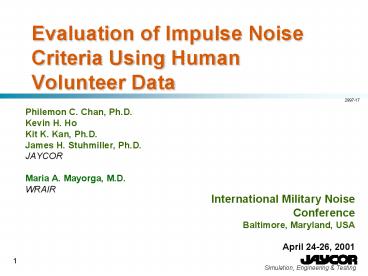Philemon C. Chan, Ph.D. - PowerPoint PPT Presentation
1 / 14
Title:
Philemon C. Chan, Ph.D.
Description:
BOP Human Data (Modified Muff) Modified muff to simulate poor fit ... REAT reduced by about 10 dB compared to unmodified muff. Free Field Test parameters ... – PowerPoint PPT presentation
Number of Views:197
Avg rating:3.0/5.0
Title: Philemon C. Chan, Ph.D.
1
Evaluation of Impulse Noise Criteria Using Human
Volunteer Data
2997-17
- Philemon C. Chan, Ph.D.
- Kevin H. Ho
- Kit K. Kan, Ph.D.
- James H. Stuhmiller, Ph.D.
- JAYCOR
- Maria A. Mayorga, M.D.
- WRAIR
International Military Noise Conference Baltimore,
Maryland, USA April 24-26, 2001
2
Introduction
- Problem
- US military impulse noise exposure is governed by
MIL-STD-1474D - New weapons exceed the allowed exposure levels
for single protection - There is reason to believe current standard is
overly conservative - Background
- Criteria must use freefield pressure data
- Four major criteria have been proposed by NATO
members since 1968 - USAMRMC human walk up study data were collected
from 1989-1995 (Johnson, D., USAARL 94-2) - Objective
- Assess four auditory criteria against data from
human volunteers using single hearing protection
3
Criteria Definition (Single Protection)
With 15-dB attenuation assumed for modified
earmuff based on REAT data
4
Peak-Based Criteria
Auditory Criteria.xls
- Peak-based auditory criteria with single hearing
protection and N1. - No distinction of hearing protection for MIL-STD
- 15 dB global attenuation added to Pfander and
Smoorenburg for modified muff based on averaged
REAT from 500-2000 Hz (Brinkmann, 1994)
5
BOP Human Data (Modified Muff)
Free Field Pressure
- Modified muff to simulate poor fit
- Plastic tubes inserted through ear seals to
introduce leak - REAT reduced by about 10 dB compared to
unmodified muff - Free Field Test parameters
- Distances 5m, 3m, 1m
- Levels (1-7)
- Number of shots (6,12,25,50,100)
- Peak P 174-196 dB
- TA 0.8-2.9 ms
- Bunker Test
- 7 levels, N1, 2, 3
- Total data set
- 192 subjects
- 2000 exposures
- Injury TTS225 dB
6
Free Field Walk-up Test Matrix and Data
1-Meter Distance
3-Meter Distance
7
Walk-up Test Matrix and Data contd.
Bunker Test
5-Meter Distance Free Field Test
8
MIL-STD-1474D vs. Free Field Test Data
9
Statistical Analysis
- Data used at each test condition
- Results of all subjects actually tested
- Presumed failures from all subjects who failed at
lower L - Logistic Regression by maximum likelihood,
(Hosmer Lemeshow, 1989) - lnp/(1-p) b0 b1 L (pFailure probability)
- L L(P, T, N) (Continuous criteria variable)
- Population-averaged model with exchangeable
autocorrelation to model walk-up test - Confidence interval estimated using robust
formula by Huber and Royall (1967) - Computations using STATA Software
10
Data Comparison with Correlation
MIL-STD-1474D
Pfander
mf_ep_t35_subjid.xls
mf_ep_t35_subjid.xls
11
Data Comparison with Correlation contd.
Smoorenburg
LAeq8
12
Logistic Regression Results
- Observed thresholds are higher than all four NATO
criteria by 9.6-21.2 dB - Best-fit model obtained by backward stepwise
elimination - TC and TD eliminated
- Negative TB coefficient
- 3.44 log N trading instead of 10 or 5 log N
- Highest goodness of fit p-value
13
Data Comparison with Best Fit Correlation
mf_ep_t35_subjid.xls
14
Protection Analysis and Discussion
- Protection level has been successfully calculated
for 95 protection with 95 confidence interval
for each criterion - Analysis indicates that all four criteria are
overly conservative by 9.6-21.2 dB - Assumption of global correction for protection
may be inadequate - Protection depends on intensity and spectral
effects - Study is still limited for high intensity noises
- Effects of variable presentation rate and
intensity combination are not studied - Wave types studied are limited
- Based on this population of subjects and
collection of blast waves, then 95 protection
against TTS25 dB with 95 confidence can be
achieved for LMthan current MIL-STD threshold





























![[PDF] Hatsune Miku: Rin-Chan Now! Volume 2 Kindle PowerPoint PPT Presentation](https://s3.amazonaws.com/images.powershow.com/10089849.th0.jpg?_=20240801088)

